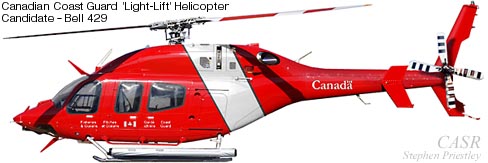
Federal government confirmation that Bell Helicopter Textron Canada (BHTC) of Mirabel, Que., will supply one fleet of Canadian Coast Guard helicopters despite an ongoing lawsuit – coupled with the prospect that Bell is the only remaining contender for a contract to renew a second CCG helicopter fleet – are prompting new questions about the government’s procurement policies.
The first contract, worth up to $172 million and effectively sole-sourced, is for 15 light-lift twin-engine Bell 429s. It was announced jointly May 13 by Fisheries and Oceans Minister Gail Shea, whose portfolio includes the CCG, and Infrastructure Minister Denis Lebel, the government’s chief political minister in Quebec.
The 429s will replace the CCG’s 14 remaining MBB BO-105-CBS helicopters, which were manufactured in Germany but assembled and delivered by Eurocopter Canada between 1983 and 1987. First delivery is expected to begin in June 2015 and the rest would follow at roughly one-month intervals.
At the beginning of the procurement process in August 2012, other contenders were the AgustaWestland AW109 and Eurocopter’s EC135 or 145. However, the Statement of Requirements specified aircraft with landing skids rather than hydraulically-damped wheels, prompting one industry source to describe the procurement process as a “sham” rather than a true competition.
AgustaWestland, a division of the Finmeccanica conglomerate, also challenged a Transport Canada decision in late 2011 – while Lebel was Transport Minister – to give Bell a 500-pound weight exemption for the 429. That regulatory decision increased its maximum gross weight to 7,500 pounds, effectively skewing the procurement toward Bell.
Renamed Airbus Helicopters last August, Eurocopter filed a lawsuit in Federal Court of Canada against the government’s decision. The company’s lawyer, Marc-André Fabien, a senior partner in Fasken Martineau’s Montreal office, said May 14 that the government’s approach to the procurement “clearly” had been focused on Bell from the outset. He also suggested that the same is true of the medium-twins procurement.
Fabien, whose specialties include litigation against all levels of government, said the contract should not have been awarded at least until a judge rules on the merits of the suit after hearing arguments later this year.
Airbus Helicopters said in a statement from its headquarters in Fort Erie, Ont., that it “deeply regrets that the federal government moved forward and awarded the . . . contract” even though its legal suit is unresolved.
“Airbus Helicopters Canada maintains that the government’s Request for Proposals . . . was biased to favour one manufacturer and consequently resulted in a sole source tender. Furthermore, Transport Canada’s awarding of a special weight exemption to Bell Helicopter in 2011 created an unfair competitive advantage and contributed to this RFP attracting only one bid.”
Citing its “strong presence in para-public and defence markets around the world” and its status as “the civil market leader” in Canada, Airbus Helicopters pointed out that it has invested “heavily” in Canada for three decades and said that it expected “to compete in fair, open and transparent public tender processes.”
Neither Shea nor Lebel mentioned the court case in their joint announcement. Shea said the fleet renewal would “improve the Coast Guard’s air support capability from coast to coast and in Canada’s North” while LeBel focused on the contract’s economic benefits for his home province.
As for the proposed eight medium-lift helicopters, they would replace three late 1960s Bill 206Ls and five late 1970s Bell 212s, all manufactured in the United States. At the outset, the potential replacements included the Bell 412, the AgustaWestland AW139, the EC175 and the Sikorsky S76D.
However, due to an 11,000-pound weight limit set by the CCG, AgustaWestland, Airbus and Sikorsky have all withdrawn from bidding. The two European-controlled companies had advised PWGSC of their decision some months ago but neither they nor the government confirmed it at the time and PWGSC has since declined comment.
When Sikorsky later confirmed its withdrawat, it disclosed that it had evaluated the H-60 it supplies to the United States Coast Guard as well as the S-76D, and although the S-76D “appeared to be the best fit”, it chose “after careful consideration” not to offer either aircraft.
Some 65 per cent of CCG helicopter operations is used to support construction and maintenance of aids to navigation and telecommunications equipment, 15 per cent is for ice reconnaissance as part of the CCG’s icebreaking mission, and the rest involves personnel and cargo transfers, and support for scientific research and fisheries enforcement
Diplômé universitaire en histoire, journalisme et relations publiques, en 1993, Philippe Cauchi amorce une carrière de journalisme, analyste et consultant en aérospatiale. En 2013, il fonde avec Daniel Bordeleau, le site d’information aérospatial Info Aéro Québec.
Commentaires